Search the Special Collections and Archives Portal
Search Results

Photograph of Howard Hughes, Le Bourget, France, July 1938
Date
1938-07
Archival Collection
Description
Description printed on accompanying strip of paper: "Howard Hughes reading maps and studying his way in the meteorological office at the Le Bourget. July 1938"
Image
Kenneth Hughes, brother of Pahrump resident Leon Hughes, atop a calf at the Pahrump Ranch, 1937
Level of Description
File
Archival Collection
Nye County, Nevada Photograph Collection
To request this item in person:
Collection Number: PH-00221
Collection Name: Nye County, Nevada Photograph Collection
Box/Folder: Folder 14
Collection Name: Nye County, Nevada Photograph Collection
Box/Folder: Folder 14
Archival Component
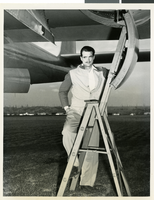
Photograph of Howard Hughes, standing by the XF-11, April 3, 1947
Date
1947-04-03
Archival Collection
Description
Transcribed from attached press release: "HUGHES READY FOR TAKE-OFF IN SECOND XF-11 FLIGHT. CULVER CITY, Calif., April 5. Howard Hughes, famed flier-industrialist, recovered from injuries following crash last July 7, is shown here just before he test-piloted today a duplicate of the plane in which he nearly lost his life. He designed and built the plane, designated XF-11, and one of the world's fastest photo-reconnaissance ships, for the Army Air Forces in conjunction with the Air Materiel Command engineers."
Image
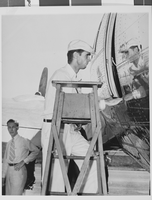
Photograph of Howard Hughes in Glendale, California, August 26, 1939
Date
1939-08-26
Archival Collection
Description
Description given with photograph: "Howard Hughes is shown entering his Boeing Stratoliner at Glendale, Calif 8/26/39"
Image
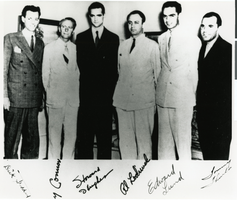
Photograph of Howard Hughes and other men, circa 1935-1945
Date
1935 to 1945
Archival Collection
Description
L-R: Dick Goddard, (?) Connor, Howard Hughes, Al Lodrinek (sp?), Edward Lund, Tommy (?).
Image
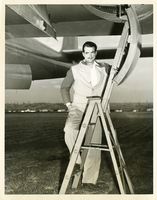
Photograph of Howard Hughes underneath the XF-11 plane, April 3, 1947
Date
1947-04-03
Archival Collection
Description
Howard Hughes stands on a ladder underneath the body of XF-11 plane.
Image
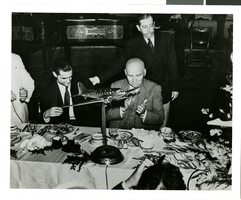
Photograph of a banquet for Howard Hughes, Los Angeles, August 1, 1938
Date
1938-08-01
Archival Collection
Description
A view of Howard Hughes (left), California Governor Frank Merriam (center, front), and Will Hays (center, back) at a banquet held for Howard Hughes in the Biltmore Hotel in Los Angeles, California.
Image
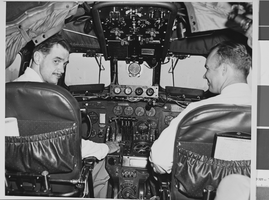
Photograph of Howard Hughes installing radar, Culver City, California, May 03, 1947
Date
1947-05-03
Archival Collection
Description
Description given with photo: "Hughes Pilots Radar-Equipped Plane Culver City, Calif. -- First passenger plane equipped with radar is flown in demonstration May 1st by Howard Hughes (left) and co-pilot R.C. Loomis over Culver City. Pilots using this equipment will be warned of approaching obstacles by lights flashing on radar panel. Two lights (lefts) with 2,000-foot range, are used to guarantee clearance over mountains; two lights (right) with 500-foot range, are a safety device for approaches and landings. Either set of lights warns against approaching aircraft. Trans-World Airline plans to install radar on its passenger planes. Credit (ACME) 5-3-47."
Image
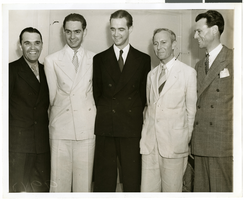
Photograph of Howard Hughes and a group of men, August 01, 1938
Date
1938-08-01
Archival Collection
Description
Description printed on photograph's accompanying sheet of paper: "Howard Hughes and his crew of globe girdlers (L-to-R) Thomas Thurlow, Ed Lund, Albert Lodwick, Hughes, Harry Connor and Dick Stoddart. 8-1-38. (Press Association)." Howard Hughes is standing third from the left.
Image
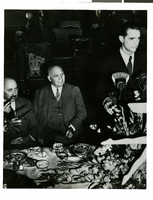
Photograph of a banquet for Howard Hughes, Los Angeles, August 1, 1938
Date
1938-08-01
Archival Collection
Description
A view of Howard Hughes giving a speech at a banquet dedicated to him located inside of the Biltmore Hotel in Los Angeles, California. California Governor Frank Merriam can be seen sitting behind Howard Hughes, sitting second from the left.
Image
Pagination
Refine my results
Content Type
Creator or Contributor
Subject
Archival Collection
Digital Project
Resource Type
Year
Material Type
Place
Language
Records Classification
